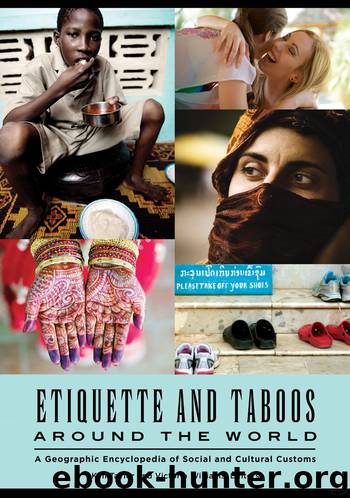Etiquette and Taboos around the World by Ken Taylor

Author:Ken Taylor
Language: eng
Format: epub
ISBN: 9781440838217
Publisher: ABC-CLIO
M
MADAGASCAR
The island nation of Madagascar, which lies off the coast of southeast Africa in the Indian Ocean, was one of the last large places to be inhabited by humans. People from Borneo, after stopping first in coastal Africa, brought their Austronesian language, Malagasy, to the island a mere 2,000 years ago. While some people conclude that Madagascar must be an isolated country, cut off from much of the world, the opposite happens to be the case. Much of Malagasy etiquette derives from contact with other peoples and cultures. Their taboos, known as fady in their language and seemingly shrouded in exoticism, have drawn outsiders to the island over the last 300 years in an attempt to understand them. In both etiquette and taboos, Malagasy people reinforce their regard for hierarchy that favors the old over the young.
In a Malagasy dictionary one finds the word “etiquette” meaning respectful customs of good and successful people. Complete strangers typically meet and greet each other with the utmost respect, referring to the other with the terms for lord or master with no gender designations. Greeting with a “Hi/Bye” is not the norm in Madagascar. After accepting a greeting, a conversation ensues, often with polite references to the welfare of people known to both parties in the dialogue. Much of this speech behavior is built into the language. Malagasy grammar takes the spotlight off the speaker and moves it onto a more ambiguous, and therefore more powerful, canvas. True meanings and feelings are hidden within the conversation indirectly. For speakers of other languages who pride themselves on direct speech—with active verbs and clear identifications of the doers of the action—and on providing clarity with as little effort for the listener or reader as possible, the Malagasy way of demanding an effort on the other’s part can be disconcerting.
In appearance and dress, much has changed since the islanders came into contact with Europeans. Merina royalty who sought to unify the entire island, beginning with King Andrianampoinimerina in the late 1780s and ending with Queen Ranavalona-Manjaka in the early 1860s, borrowed liberally from the fashion of English and French royalty with whom their emissaries had visited. Missionaries campaigned against people wearing fetishes and relics of ancestors, and confiscated and burned objects that distracted Malagasy from God. With French colonization, more European styles of casual dress—short-sleeved shirts and shorts—were adopted by the population. Many coastal people, however, continue to enjoy the east African or Swahili kanga, the long wrap cinched at the waist with colorful patterns and interesting word phrases called lambahoany.
Netiquette among Malagasy speakers, at least among the majority of expatriates writing in the Malagasy language about political matters, tends to subvert the cultural politeness they exhibit towards one another when they are together in person. Personal identity is often masked on the Web but not their feelings towards political positions. They are often quite brutal with one another as they discuss politics back home. It is as if the virtual space of the Web has unveiled
Download
This site does not store any files on its server. We only index and link to content provided by other sites. Please contact the content providers to delete copyright contents if any and email us, we'll remove relevant links or contents immediately.
| Anthropology | Archaeology |
| Philosophy | Politics & Government |
| Social Sciences | Sociology |
| Women's Studies |
Cecilia; Or, Memoirs of an Heiress — Volume 1 by Fanny Burney(32377)
Cecilia; Or, Memoirs of an Heiress — Volume 3 by Fanny Burney(31752)
Cecilia; Or, Memoirs of an Heiress — Volume 2 by Fanny Burney(31718)
The Great Music City by Andrea Baker(31087)
We're Going to Need More Wine by Gabrielle Union(18906)
All the Missing Girls by Megan Miranda(15400)
Pimp by Iceberg Slim(14219)
Bombshells: Glamour Girls of a Lifetime by Sullivan Steve(13928)
Talking to Strangers by Malcolm Gladwell(13135)
Norse Mythology by Gaiman Neil(13132)
Fifty Shades Freed by E L James(13123)
For the Love of Europe by Rick Steves(12353)
Crazy Rich Asians by Kevin Kwan(9125)
Mindhunter: Inside the FBI's Elite Serial Crime Unit by John E. Douglas & Mark Olshaker(9107)
The Lost Art of Listening by Michael P. Nichols(7360)
Enlightenment Now: The Case for Reason, Science, Humanism, and Progress by Steven Pinker(7085)
The Four Agreements by Don Miguel Ruiz(6542)
Bad Blood by John Carreyrou(6477)
Weapons of Math Destruction by Cathy O'Neil(6085)
